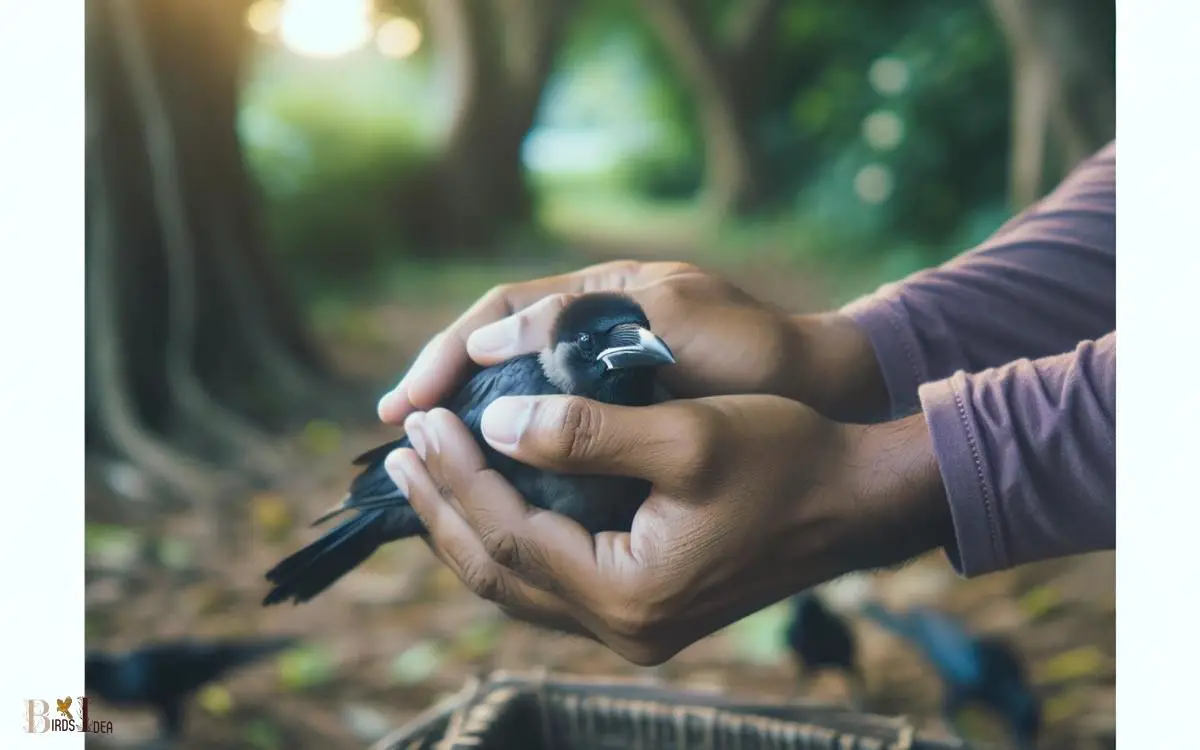Injured Crow What to Do? A Comprehensive guide!
If you find an injured crow, the most important steps are to safely contain the bird, keep it calm, and contact a wildlife rehabilitator or veterinarian for expert care.
Do not attempt to feed or water the crow, as improper care can cause harm.
When encountering an injured crow:
- Assess the situation: Check for immediate dangers to yourself or the bird.
- Contain the crow: Gently place the bird in a well-ventilated box with a lid.
- Keep the crow calm: Minimize noise and interaction to avoid stress.
- Contact professionals: Reach out to a local wildlife rehabilitator or veterinarian for guidance.
- Do not feed or water: Incorrect feeding can be detrimental.
- Do not attempt to treat injuries: Handling the bird can cause more harm.
An injured crow requires professional care to recover. Immediate, correct action by those who find the bird can be the bridge to its survival and return to the wild.

Key Takeaway
Identifying the Injury
One must carefully observe the crow to identify the nature and extent of its injury. Look for any signs of physical trauma such as limping, wing drooping, or difficulty in flying.
Pay attention to the crow’s behavior; signs of distress, agitation, or unusual vocalizations may indicate pain or discomfort. Take note of any visible wounds, bleeding, or swelling.
It’s important to approach the crow with caution, as injured animals may become defensive or frightened.
Once you have observed the crow and noted its condition, you can proceed to the next step of assessing the crow’s condition, which will help determine the best course of action for providing the necessary care and support.
Assessing the Crow’s Condition
The first step in assessing the crow’s condition is to carefully observe its physical symptoms and behavior for indications of injury or distress.
When evaluating the crow, consider the following:
- Look for any obvious signs of injury such as limping or difficulty flying.
- Observe the crow’s posture and body language for signs of pain or discomfort.
- Check for any visible wounds or bleeding.
- Note the crow’s breathing patterns and whether it appears labored.
- Pay attention to the crow’s overall alertness and responsiveness to stimuli.
Assessing these factors can provide valuable insight into the crow’s condition, helping to determine the appropriate course of action.
It’s important to approach the assessment with patience and attentiveness to ensure an accurate evaluation.
Providing Temporary Shelter
When providing temporary shelter for an injured crow, it is crucial to ensure that the shelter is safe and warm to promote healing.
The shelter should be designed to protect the crow from predators, minimizing stress and potential harm.
Easy access for providing necessary care and monitoring the crow’s condition is also essential in this critical period of recovery.
Safe, Warm Shelter
Providing an injured crow with a safe and warm shelter is essential for its recovery and well-being.
When creating a shelter for an injured crow, consider the following:
- Insulation: Ensure the shelter is well-insulated to retain warmth and protect the crow from harsh weather conditions.
- Ventilation: Provide adequate ventilation to prevent the buildup of moisture and ensure the crow can breathe comfortably.
- Protection: Place the shelter in a safe location, away from predators and potential hazards.
- Comfort: Use soft and non-toxic materials to create a comfortable and inviting space for the crow to rest and recover.
- Accessibility: Make sure the shelter is easily accessible for you to check on the crow and provide necessary care.
Protect From Predators
- To ensure the safety of the injured crow, a sturdy temporary shelter should be provided to protect it from predators.
- This shelter should be secure and elevated, out of reach of ground-dwelling predators such as cats and dogs.
- It’s crucial to use materials that will withstand weather elements and potential predators. An ideal option is a small, ventilated box with a secure lid.
- Ensure the shelter is placed in a quiet and secluded area, away from human and animal traffic, to minimize stress on the injured crow.
- Consider using deterrents such as predator-proof netting or wire mesh around the shelter.
- By providing a safe and secure temporary shelter, the injured crow can rest and recover without the risk of further harm from predators.
- For easy access to provide care, the shelter should be placed in a location that allows for close observation and quick intervention if needed.
Easy Access for Care
For convenient care access, place the temporary shelter in a location allowing close observation and quick intervention if needed.
This will ensure the injured crow receives the necessary care and attention while minimizing stress.
Here are some tips for setting up an easy access temporary shelter:
- Choose a quiet area away from heavy foot traffic and potential disturbances.
- Ensure the shelter is easily accessible for regular monitoring and care.
- Provide adequate protection from the elements, such as wind, rain, and direct sunlight.
- Use natural materials to blend in with the surroundings and provide a sense of security for the injured crow.
- Keep the shelter at a safe distance from potential hazards like roads or aggressive animals.
Once the temporary shelter is in place, the next step is seeking professional help for the injured crow’s recovery.
Seeking Professional Help
When dealing with an injured crow, seeking professional help is crucial for its well-being.
A qualified veterinarian can provide medical attention and treatment specific to the crow’s injuries.
Contacting a wildlife rehabilitation center can ensure that the crow receives the necessary care and rehabilitation to recover and potentially be released back into the wild.
Veterinarian for Injured Crow
Seeking the assistance of a qualified veterinarian is crucial when dealing with an injured crow.
When searching for a veterinarian for an injured crow, consider the following points:
- Look for a veterinarian experienced in treating wild birds.
- Ensure the veterinarian has the necessary permits and expertise to handle and treat injured crows.
- Inquire about the availability of emergency care, especially if the crow’s condition is critical.
- Seek recommendations from local wildlife rehabilitation centers or bird rescue organizations for trusted veterinarians.
- Confirm that the veterinarian is knowledgeable about the legal and ethical aspects of treating injured crows.
Choosing the right veterinarian can significantly impact the crow’s chances of recovery, so it’s essential to find a professional who is qualified and experienced in avian care.
Wildlife Rehabilitation Center
The injured crow can benefit from professional care at a wildlife rehabilitation center specialized in avian treatment.
These centers are equipped with the necessary resources and expertise to provide proper medical attention, rehabilitation, and eventual release back into the wild.
Seeking help from a wildlife rehabilitation center ensures that the crow receives the best possible care and has the highest chance of survival and successful release.
Here is a brief overview of the services provided by wildlife rehabilitation centers:
| Services | Description | Benefits |
|---|---|---|
| Medical Treatment | Diagnosis and treatment of injuries and illnesses, including x-rays, surgeries, and medications | Proper healing and recovery |
| Rehabilitation | Physical therapy, conditioning, and behavioral support to prepare the crow for release | Increased chance of survival in the wild |
| Release Preparation | Providing a safe environment for the crow to regain strength and skills needed for survival | Successful integration back into the wild |
Offering Food and Water
Once the injured crow has been safely contained, it is important to offer it appropriate food and water to support its recovery.
- Fresh Water: Ensure the crow has access to clean, fresh water at all times.
- Healthy Diet: Provide a varied diet including seeds, fruits, and small insects to meet its nutritional needs.
- Avoid Processed Foods: Refrain from offering processed or salty foods, as these can be harmful to the crow’s health.
- Regular Feeding Schedule: Establish a regular feeding schedule to help the crow regain its strength.
- Monitoring: Keep an eye on the crow’s food and water intake to ensure it is eating and drinking adequately.
By providing the injured crow with nourishing food and water, you can significantly contribute to its recovery.
Next, we’ll explore strategies for minimizing stress and disturbance.
Minimizing Stress and Disturbance
To ensure the injured crow’s well-being, it is imperative to minimize stress and disturbance during its recovery process.
Place the crow in a quiet, warm, and dimly lit area to reduce sensory stimulation. Limit human interaction and keep other pets away to prevent unnecessary stress.
Keep the crow’s environment as calm and peaceful as possible, avoiding sudden loud noises or movements.
Cover the enclosure partially to provide a sense of security and minimize visual disturbances.
Minimizing stress and disturbance is crucial for the crow’s recovery, as it allows the bird to conserve energy for healing.
By creating a tranquil environment, the crow can focus on recuperation without unnecessary agitation, aiding in a swifter and more successful recovery.
Monitoring the Crow’s Progress
After minimizing stress and disturbance for the injured crow, monitoring its progress is essential to track its recovery and ensure appropriate care.
Here are five key steps to effectively monitor the crow’s progress:
- Regularly observe the crow’s behavior and movement patterns.
- Document any changes in the crow’s condition, such as improved mobility or increased alertness.
- Keep track of the crow’s food and water intake to ensure it is receiving adequate nourishment.
- Monitor the healing process of any visible injuries or wounds.
- Seek professional advice if there are any concerning developments or lack of progress in the crow’s recovery.
Conclusion
It is crucial to immediately identify and assess the injury of an injured crow. Providing temporary shelter, seeking professional help, offering food and water, and minimizing stress and disturbance are essential steps in aiding the crow’s recovery.
Monitoring the crow’s progress is vital to ensure its well-being. Failure to take these steps could result in dire consequences for the injured crow.






